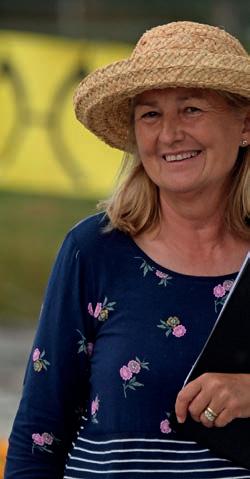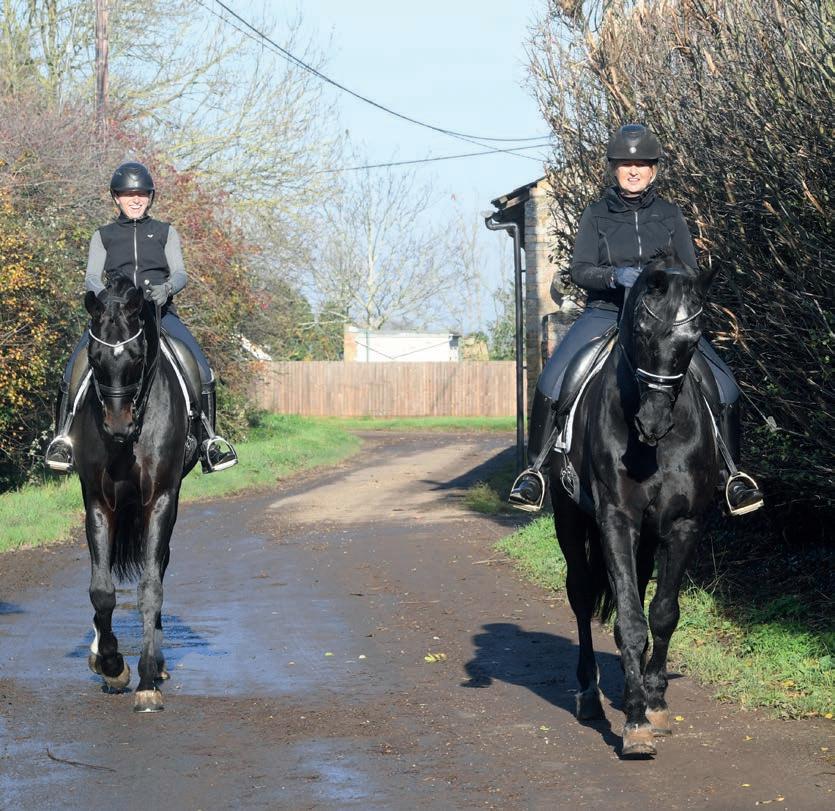
8 minute read
Profi le Breeder and
BREEDING WITH PURPOSE



AFTER 45 YEARS DEDICATION TO BREEDING DRESSAGE HORSES, BRITISH HANOVERIAN HORSE SOCIETY (BHHS) CHAIRMAN KATY HOLDERVALE SHOWS NO SIGNS OF SLOWING DOWN AND HAS EMBRACED HOW TECHNOLOGY HAS COME INTO PLAY IN THIS MOST DIFFICULT OF YEARS, REPORTS POLLY BRYAN.
Katy Holder-Vale wears many hats: dressage rider, breeder, judge for the German Hanoverian Horse Society, chairman of the British Hanoverian Horse Society (BHHS), and owner of Witcham House Stud in Cambridgeshire. I wonder how she juggles it all, that is until I meet her, virtually – we’re in lockdown 2.0 after all – and realise that she is a person brimming with energy and positivity.
In her 45-year career, there are very few aspects of dressage breeding she hasn’t had a hand in, and certainly when it comes to Hanoverians. aty’s love aff air with the breed began in when she was off ered a Hanoverian stallion named Maple Drambuie by a friend – the alternative was that the horse would be put down.
“He was a dear horse and he proved to be a great stallion,” Katy, 63, recalls. “He was one of the fi rst Hanoverians over here in Britain and he was very popular. We’re close to Newmarket so there are a lot of thoroughbred mares in the areas, and that proved a fabulous combination. He gave me the bug for Hanoverians.”
LEFT: KATY HOLDER-VALE WITH HER STALLION FLAMMENGOLD, BY FLORESTAN, WHO SHE SAYS BREEDS IN RIDEABILITY AND TRAINABILITY. RIGHT: KATY IS CHAIRMAN OF THE BRITISH HANOVERIAN HORSE SOCIETY AND A JUDGE FOR THE GERMAN HANOVERIAN HORSE SOCIETY.
Next came Glücksfall, a licensed stallion whom aty describes as one of the fi rst modern Hanoverians – elegant with long legs.
“From there I wanted to really understand Hanoverians, and to train as a judge,” explains Katy, who has held her full judging status for 25 years. So what was it about Hanoverians in particular that interested her?
“Originally it was the structure and discipline behind the way the society breeds,” Katy tells me. “It’s been said that the Germans breed with their heads and the English breed with their hearts. Sometimes English breeders really get it right of course, but the Germans have always been well ahead of the game in terms of statistics and studbooks and their research into mare lines. “I also really liked the fact that even then, they were only breeding from graded mares and licensed stallions. Consequently, selling dressage foals is easier; Hanoverian breeders are always trying to breed a product that the market wants to buy, and so they breed with purpose.”
Breeding with purpose, and for a targeted market is something Katy feels strongly about. She explains she has always bred mostly for amateurs, and as a result temperament is her main priority. She is a huge fan of Florestan, sire of her own Flammengold, one of two stallions she currently stands at Witcham House.
“Florestan always breeds in rideability and trainability, and that is worth a lot,” she says. “Flammengold also stamps his stock very strongly.”
Katy emphasises the importance of breeders making clever, educated choices, in understanding exactly what their mare brings to the table, and carefully choosing a stallion who will make valuable improvements. But she also appreciates the importance of opting for a stallion who will give foals much-needed saleability. “ hen I fi rst started breeding we didn’t have any foreign semen coming into this country – Maple Drambuie would have 40 mares in a season. But now everyone can shop abroad, and they know they will be able to sell a foal easier if it’s by a fashionable German stallion.
“It’s hard for Brits to compete against the well promoted stallions on the Continent, so if you are standing a stallion here, you have to gain a competition record with him. In the past we had warmbloods who did nothing except look beautiful, but now to stand out your stallion has to be a competition horse.”
She uses Dimaggio as an example of a British stallion that can have the sort of impact on European breeders as we are used to foreign stallions having here.
“I was on the stallion committee [of the BHHS] when Dimaggio was a two-year-old and it was fascinating to see him develop. He was one of the fi rst thoroughly elegant athletic stallions that really passed on that athleticism, and he came at a really good time when we had a lot of big old-fashioned mares that he crossed well with.
As well as Flammengold, whom she competed at small tour until 2018, Katy also stands the Sandro Hit son Samba Hit III, who was successful up to inter II with Gareth Hughes, and more recently Henry Boswell.

ABOVE: SAMBA HIT III AND FLAMMENGOLD HACKING OUT TOGETHER. BELOW: SAMBA HIT III, BY SANDRO HIT, DESCRIBED BY KATY AS ‘A COMPLETE CHARMER’.
BHHS] when Dimaggio was a two-year-old

ABOVE: KATY BELIEVES THAT STALLIONS NEED A COMPETITION RECORD TO APPEAL TO BREEDERS; SAMBA HIT II HAS COMPETED TO INTER II. RIGHT: KATY HAS BEEN BREEDING HORSES FOR 45 YEARS, AND RUNS WITCHHAM HOUSE STUD AT ELY, CAMBRIDGESHIRE. BELOW: KATY COMPETED FLAMMENGOLD AT SMALL TOUR UNTIL 2018.
“Samba Hit is a complete charmer. He and Flammengold live next door to each other and spend all their time with their noses pressed together through the grille that divides their stables,” says Katy.
Her own breeding operation has scaled down in recent years, but she tells me that she always aims to cater to the market.
“If lots of people want foals, we breed more foals,” she says. “It’s blooming hard work; we bred up to 14 a year at one point, but this year we had four and it was fantastic. They are all better behaved because we had more time for them. When it is harder to sell foals we take more liveries, and we also have some Flammengold children that my girls compete.”
I’m interested to hear her thoughts on how the coronavirus pandemic has aff ected the market this year, and she admits she has been pleasantly surprised.
“In March when breeders were making their decisions, I thought they would do less and be more fi nancially cautious but that hasn’t been the case. When we came out of the fi rst lockdown it went cra y. ooking at the stats, the BHHS will register more foals this year than ever. It’s very exciting.”
The pandemic has prompted everyone to diversify, and one example of this was judging the Futurity series virtually. Again, Katy is full of positivity for this year’s new way of working. “It was much better than we expected. I was surprised by how well we could judge the horses via video, but when you’re experienced you’ve seen most of what you need to in the fi rst two minutes. Training in Germany, where it all happens so fast it’s unbelievable, your eye becomes quick, and you learn to look to a lot of things all at once. And of course fi rst impressions are so important.
“Some people do need to learn how to make their videos better, but it’s the same as being in the ring, where some really make the best of their horses and others don’t. We can only mark what we see, even if we know a horse could show us more. We always want to give an animal the best mark we can.” While it is of course the horses that make breeding so rewarding, it is people who make it happen, and Katy is as passionate about the education of breeders and investing in future human generations as she is about improving quality of stock.
“I’m proud of our British breeders – they have really educated themselves and looked at what has been successful, not only which stallions are fashionable but also what they actually bring to the table, and the importance of mare quality too. People are more discerning about the horses they put forward for grading. And the Futurity series has been brilliant for British breeding, especially having the veterinary input. It’s helped make breeders aware of things like foot balance, and how important it is in ensuring a horse moves straight.
“The standard of dressage horses in this country is going through the roof, and it’s great to see more of our top riders riding British horses,” she adds. “And we are seeing more riders getting into breeding themselves too, and that’s great. It’s not easy – having breeding horses is very diff erent to having competition horses. But developments like embryo transfer have made an enormous diff erence and of course it means we have more top riders on mares now.”
Katy says her greatest motivation comes through judging, and that she is still learning all the time. She’s the sort of person to jump at every opportunity, such as judging at the world championships for young breeders, and travelling to countries like Australia and Canada to inspect horses. Her passion for breeding is profound and, thankfully for the industry, shows no signs of waning.
year than ever. It’s very exciting.”
The pandemic has prompted everyone to diversify, and one example of this was judging the Futurity series virtually. Again, Katy is full of positivity for this year’s new way of working. “It was much better than we expected. I was surprised by how well we could judge the horses via video, but when you’re experienced you’ve seen most of what you need of things all at once. And of course fi rst impressions are so important.
















